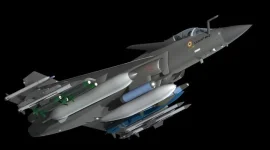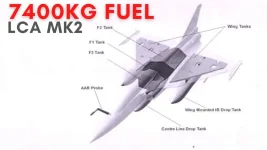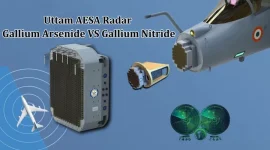- Views: 2K
- Replies: 7
The Indian Air Force’s future combat capabilities are set for a major technological leap as the Tejas Mk2 program integrates a significantly advanced radar system.
The 4.5-generation multirole fighter will feature the "Uttam Mk2," an upgraded version of the indigenous Active Electronically Scanned Array (AESA) radar.
This new iteration incorporates a mechanical "swashplate" mechanism, a critical innovation that physically repositions the radar antenna. This allows for a field of view (FOV) wider than 100 degrees, facilitating a 140-degree scanning area within a broader 200-degree look angle.
This sophisticated enhancement is spearheaded by the Electronics and Radar Development Establishment (LRDE), a laboratory under the Defence Research and Development Organisation (DRDO).
The primary goal is to overcome the "tunnel vision" often associated with traditional fixed-plate AESA radars. By mechanically steering the radar beam, the Uttam Mk2 grants pilots superior situational awareness without requiring the aircraft to execute high-G turns to keep a target in sight.
With the Tejas Mk2 prototype scheduled for its maiden flight in 2027, this technology places the Indian fighter on par with global counterparts like the Saab Gripen E (equipped with the Raven ES-05) and the Eurofighter Typhoon (equipped with the Captor-E), particularly in Beyond Visual Range (BVR) combat scenarios.
The Uttam Mk2 represents a significant evolution from the Mk1 variant currently undergoing trials on the Tejas Mk1A. A key technological shift is the transition from Gallium Arsenide (GaAs) to Gallium Nitride (GaN) semiconductor modules.
GaN technology is preferred for its superior thermal efficiency and ability to handle higher power loads, which directly translates to extended detection ranges—estimated at up to 250 km for fighter-sized targets—and robust resistance against enemy electronic jamming.
Crucially, these performance gains have been achieved while maintaining a form factor small enough to fit within the fighter’s nose cone.
Standard AESA radars, such as the baseline Uttam Mk1, typically offer a fixed field of view of roughly 60 degrees. This limitation restricts "off-boresight" missile shots, forcing a pilot to point the aircraft’s nose directly at a threat to maintain a radar lock—a dangerous necessity in modern aerial warfare.
The swashplate resolves this by mounting the radar antenna on a gimbal-like motorized plate that can tilt and pan. According to recent DRDO briefings, this allows the radar to scan widely across the azimuth and elevation, enabling the Tejas Mk2 to detect, track, and launch missiles at hostile aircraft approaching from extreme angles.
This development mirrors the capabilities of top-tier Western fighters but is being achieved with approximately 90% indigenous content, resulting in cost savings of 30-40% compared to imported alternatives.
The radar’s architecture features over 980 Transmit/Receive (T/R) modules, each generating 10-15 watts of power. This high density allows the system to track up to 64 targets simultaneously and engage six of them at once using advanced active radar-homing missiles like the indigenous Astra Mk2.
Designed to accommodate the larger fuselage of the Tejas Mk2, the radar’s scalable architecture ensures it can be seamlessly integrated with other onboard systems.
It will interface directly with the Unified Electronic Warfare Suite (UEWS), providing the pilot with a fused data picture of the battlefield.
While the technology originated from prototypes developed by the LRDE in 2021 for the "Super Sukhoi" upgrade program, it has been prioritized for the Tejas Mk2 to ensure high levels of fleet commonality and self-reliance in critical defence technologies.




